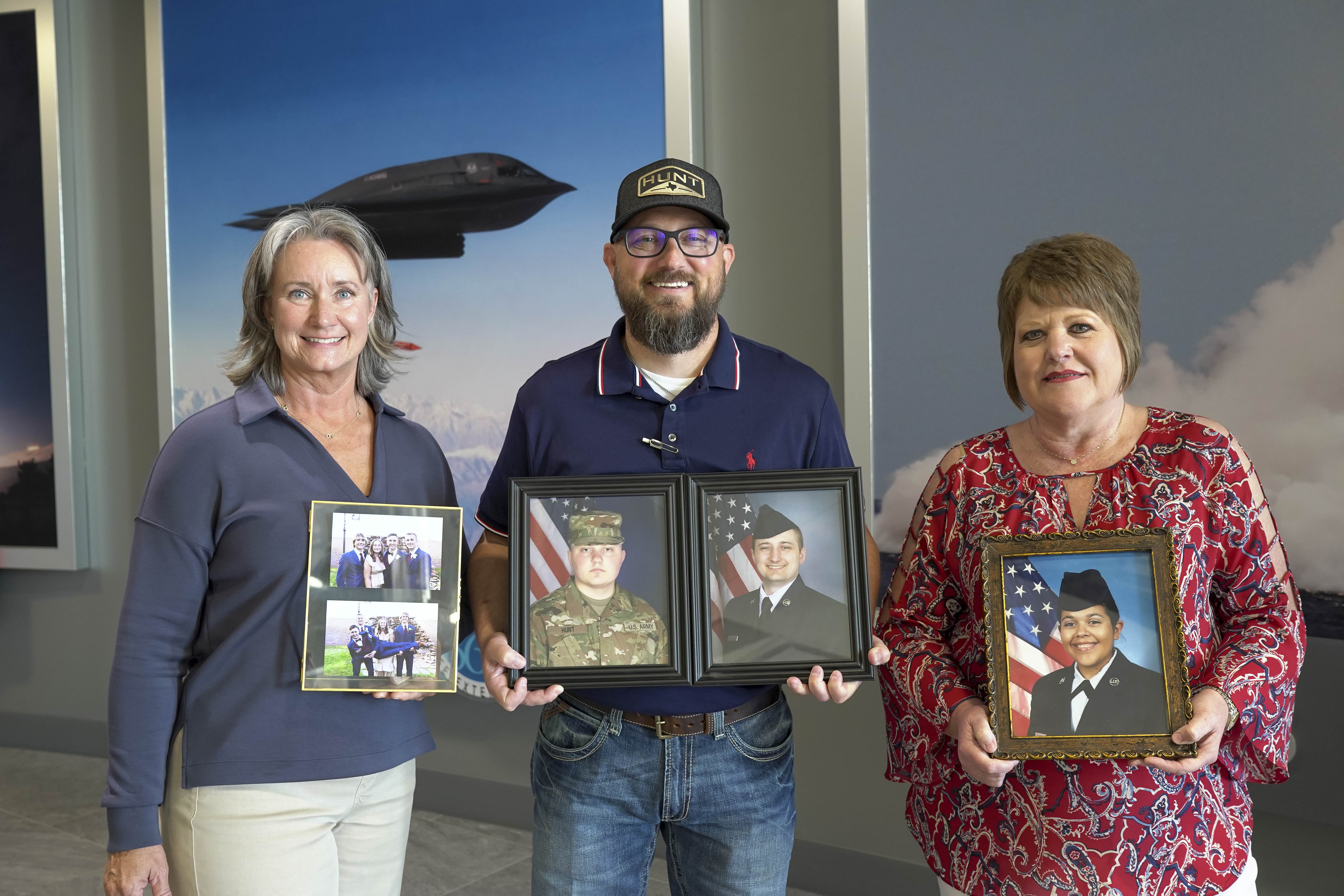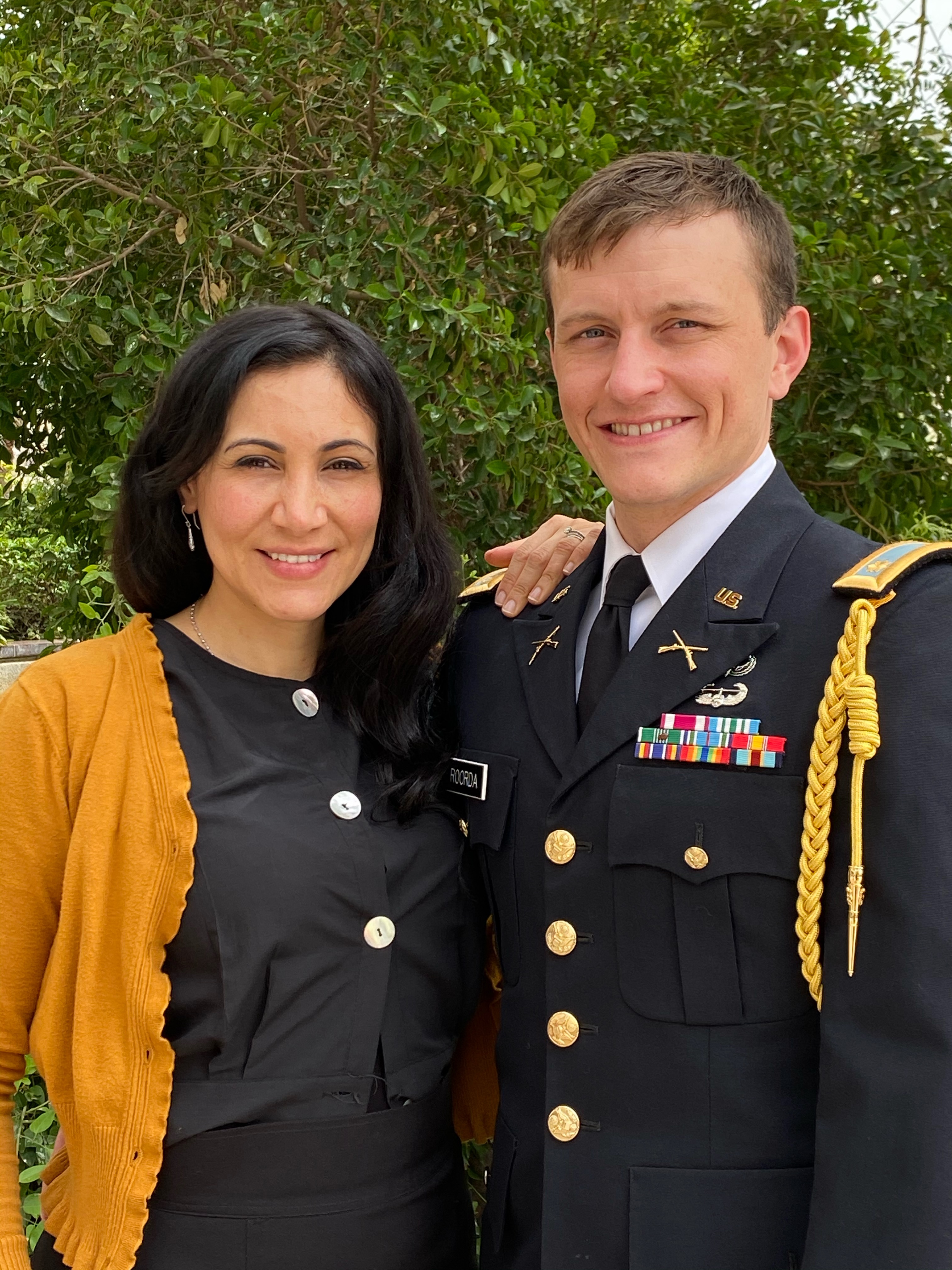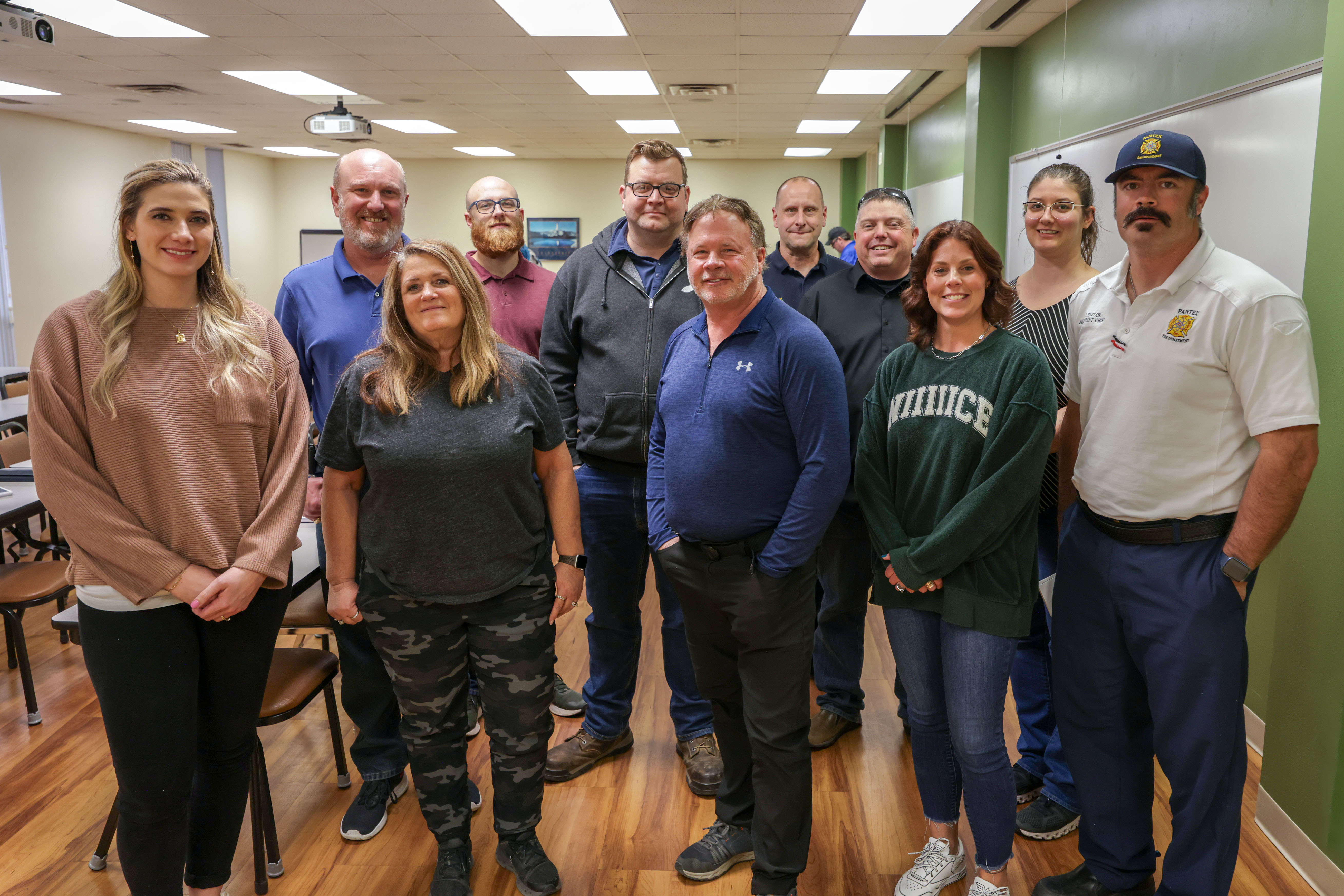Pantex Blog
Plants may be rich in wildlife, but employees should enjoy with caution

A pair of rattlesnakes warn off what they perceive as predators. Snakes like these are a common sight at Pantex, where the availability of prey and warm facilities prove inviting.
An employee replacing a Pantex air-handling unit in the ceiling felt something fall out of the ductwork onto his shoulder. Focused on his work, he brushed off the offending object…only to glance down and realize he’d just swiped away a garter snake.
Thankfully, the creature was nonvenomous, and no employees were harmed. However, that doesn’t change the fact that at Pantex, the potential to encounter wildlife—including some creatures that are potentially hazardous to humans—is an everyday reality.
At Pantex, rattlesnakes are the proverbial king of wildlife encounters, with 22 calls in 2023. Along with many other reports, an additional 38 calls reported various other species of snakes, and another 19 calls reported skunks.
“Sometimes, we’ll catch other things when trying to catch a skunk,” explained Environmental Safety & Health Generalist Katie P. “We have gotten some feral cats before. When we get cats in, we take them to the City of Amarillo, and they put them in their barn cat program, where they can be adopted by a farmer and live out a happy life chasing mice and such as that.”
The site is also seeing a boom in other wildlife populations.
“We are starting to see more deer, more pronghorn, more coyotes,” explained Pantex Wildlife Biologist Kevin B.
He cautioned employees against feeding or creating any condition that might invite a wild animal to enter an area where they should not be. The outcome, he warned, could not only create a hazard for employees but also prove tragic for the animal itself.
“They are not your pet dog,” Kevin said. “You are not helping the animal; in fact, you are hurting the animal because they are more likely to come in … and we have to deal with that.”
Pantex employees who see dangerous wildlife or wildlife acting strangely should call the site’s Operations Center. Their first duty, though, is to ensure their own safety and the safety of those around them.
“If you run across a predator-type animal and it’s acting aggressively,” Kevin said, “don’t try to approach it, but still keep an eye on it until one of our team gets there.”
A pair of mule deer cross a Pantex road that divides grazing areas.
Armed Forces Day – Families serve too

Michele M., Thomas H., and Felecia B. share photos of their family members currently serving in the Armed Forces.
Pantex Emergency Preparedness Specialist Felecia B. has always known that Pantex played a vital role in the nation’s safety and security, but it wasn’t until her daughter joined the U.S. Air Force that the site’s mission truly resonated with her.
“I have always believed in our mission, but now, after my daughter has been to 5 duty locations, 2 deployments to the Middle East, and over 20 countries, I know that what we do here directly impacts the protection of our nation, our allies, and our military members stationed around the world,” Felecia said.
Felecia’s daughter, Sergeant Katelyn V., is now stationed in Fayetteville, North Carolina. She is one of the many family members of Pantex and Y-12 employees serving in the nation’s military. As Armed Forces Day is celebrated, the military families of Pantex and Y-12 provide a clear and tangible link to the important missions of the sites but also a unique set of challenges…and worries.
Being part of a military family has challenges and benefits unique to military service. As a U.S. Army veteran myself, I know well that servicemembers give up a lot of freedoms to protect our nation, but so do the families supporting them. These families are often unrecognized for their role in service to the nation. They often don’t have a choice regarding where they will live and work.
The servicemember is deployed for months at a time, leaving the family behind to deal with the home front.
“We never realized how much those in the military sacrifice, along with their families, until now,” Felecia said. “We had taken for granted all of the family gatherings or special occasions that our daughter would now be unable to attend.”
Pantex Procurement Engineer Thomas H. has two sons and a daughter-in-law serving in three different locations, and, while he’s proud they are serving their country, he misses the time he gets to spend with them.
“Life from the aspect of military commitment means that the relationships are carried through phone and online communication,” Thomas said. “We sacrifice a lot of free-range visits for the schedule that is set by the military. If we’re lucky, the Air Force and Army block-leave assignments allow us to have everybody together at once, but most of the time, we only get a week with each of them –– once in the summer and once in the winter/holiday season.”
That longing for togetherness as well as concerns for safety are heightened when the servicemember is deployed to a combat environment. The uneasiness of whether or not you’ll see a loved one again never really leaves the mind.
“The most challenging part of being a military family is when the servicemember gets deployed to a remote location and communicating is very limited,” said Lisa H., information specialist in CNS Communications at Y-12. “This is especially challenging when the remote location is in a war zone. When your family member is away, you try to keep busy with day-to-day challenges of life, but your mind is always on the one deployed.”
Those extended deployments can stress the family environment, but they also create opportunities.

Rose R. stands with her husband, Major Brennan R., at his promotion ceremony.
“Deployments will change your spouse, cause your kids to grow up too fast, stress your marriage, and provide an amazing opportunity for growth,” said Michele M., Pantex Performance Excellence Disciplined Operations lead. “Through my husband's military obligations of weekend drills, schools, and deployments, I have grown into a stronger person. I learned to balance keeping a household going, working a full-time job, meeting the varied demands of four kids, continuing my education, and taking care of myself.”
Rose R., Y-12 administrative assistant for Nuclear Safety, describes her life as an adventure.
“Being a military family is different to lives as nonmilitary families, as expectations for your level of flexibility and resiliency are much higher than in regular civilian life” Rose said. “We have moved 7 times in the past 14 years to places like Vicenza, Italy; Tunis, Tunisia; and my husband is currently stationed in Bamako, Mali. It can be difficult to plant deep roots anywhere, but you have roots far and wide, across the U.S. or the world, wherever your posts may be.”
Like their active-duty counterparts, many military families develop deep bonds with other families they’ve been stationed with.
“Your military friends and associates become your family members, especially when serving overseas,” Lisa said. “You are in a small, remote group with the same purpose. They are family you will always maintain contact with, just as you would your immediate family. If you need help, your ‘family’ will be the ones there to assist.”
The bond that military family members who work at Pantex and Y-12 share with the armed forces also strengthens their sense of pride to be a part of the sites’ missions, knowing the work they do directly affects their servicemembers’ lives.
Thomas stated, “My job at Pantex ties me to a deeper sense of patriotism than I had before because I did not serve in the military, nor did my father. I have a deeper understanding knowing that what we do ends up in the hands of the generation I took part in raising to go forward and protect the world. That connection, and the opportunity that Pantex provides for them as a career option once their enlistment completes, gives me great pride in what I do.”
As both seen and unseen sacrifices continue to be made daily for the protection of our nation, Pantex and Y-12 would like to say “thank you” to all active servicemembers, veterans, and military families for all they have given in service to this country.
I am mission success: Kimberly H.

Take 5 minutes to learn about Kimberly H. This article details Kimberly’s role at Pantex and reinforces the diverse workplace culture CNS offers. All views and opinions are the employee’s own and do not necessarily reflect those of CNS.
When Kimberly H. started thinking about what she wanted to do with her life, she knew she wanted to be a part of something bigger. For her, this would be the American military, where she could keep growing as a person, as well as providing a way to travel the world. Kimberly, who now works in project management, originally joined the U.S. Navy to become a pilot, but things quickly changed when she started flight school.
“When I got to flight school, I realized I was much better when my feet were on the ground and not in the air,” Kimberly said. “Through that I found a better direction for myself working with the Seabees doing construction management and that has translated into a new role in national defense at Pantex. It’s not exactly the career path I expected, but I am happy it led me to where I am now.”
In addition to learning valuable lessons in flight school, it is also where she met her husband, Joshua. After deciding flying was not her speed, she became a part of the U.S. Navy Civil Engineer Corps, which she has been a part of for 15 years. Kimberly, who holds the rank of lieutenant commander, joined CNS through the SkillBridge program in January 2024, and will soon join the Navy Reserve to keep serving while she also serves through her new role at Pantex.
What top strength do you bring to your organization and why?
There are “big rocks” people who focus on the big picture with creative, strategic, and visionary ideas, and there are “little rocks” people who are detail-oriented and focus on executing individual details precisely. I think of myself as a “medium rocks” person, someone who focuses on how all the pieces and resources fit together for maximum productivity—someone who can bridge the gap between the big picture thinkers and the detailed-oriented planners to help make an idea a reality.
How has working for CNS changed or reinforced your thoughts on our mission (nuclear deterrence, managing the stockpile, etc.)?
Coming from the U.S. Navy, I have spent my career providing engineering, facilities, and construction support to assist our nation’s warfighters and our country’s highest priority missions, and nuclear deterrence has long been one of the Department of Defense’s highest priority missions. But my understanding of nuclear deterrence focused on the nuclear triad, not the vast support network that exists to ensure the effectiveness of the nation’s nuclear deterrent. Coming to Pantex, it has given me greater appreciation for the huge enterprise that exists beyond the military that is essential in the success of that mission and the number of civilians in our nation, such as those at Pantex and Y-12, who play a vital role in ensuring our national and global security.
What is your favorite aspect about your work environment? How does that aspect make you know the mission is being met?
I really enjoy working with people and collaborating. There seems to be a very strong collaborative culture here. When people are willing to come together and talk through problems to get to solutions, that is when you are able to know that the mission is going to be met.
What CNS principle drives you to be successful?
I am an industrial engineer by education, so continuous improvement and figuring out how to do things better is the core of everything we do. How can we improve to be better and more efficient? How can we build a better team through the process? I am always looking for ways to improve our processes, communication, and teamwork through that lens.
What’s your top bucket list item and why?
One of the things I would love to do one day is take a vacation to Greece. I have seen so many pictures of the Greek Island and they look beautiful. My parents also met in Greece, so it would be a fun place to visit!
Working with mom
May is the month to celebrate the mothers in our lives. Some lucky employees even have the privilege of working with their mothers on-site.

Meet Pantexan mother and son, Debbie M. and Michael O.
Michael O., end user support with Pantex Information Solutions and Services, and Debbie M., tester program coordinator in Pantex Tooling and Tester Engineering, only get a chance to see each other on-site maybe once a month, but Michael always steals a hug from his mom when he can get one.
“I’ve been given an opportunity that most children will never get, to see into the lives of their parents outside of the home and the chance to see a greater picture of the woman who raised me,” Michael said.
Michael started at Pantex in 2021, and has often relied on his mom’s 30 years of experience at the plant. Her presence made the transition less intimidating as a new employee, and even now she’s always willing to help him figure things out.
“She’s not afraid to go out and find answers, and she passed along the idea of being curious and seeing what others might not,” he said. “This has encouraged me to help mentor those around me, so I can share it with the next generation of Pantexans.”
Debbie says it warms her heart to know she can occasionally pop into the John C. Drummond Center and get a hug from her son.
“The best part of working at Pantex together is knowing that he is close to me and close to family, and the longer he works out here, he will discover that Pantex is also a family,” Debbie said.
She also loves hearing from others about how well he’s doing with his work. “They tell me he can be relied on to be accountable and get the job done,” she said. “I love that he is respected and valued in his field. I am proud of him because he is a good man.”
Pantex partners with the best to prepare for the worst

Pantexans from all over the plant joined together to train on emergency response to rural mass casualties.
Disaster can strike as quickly and unexpectedly as a rattlesnake bite while walking through weeds. Once it happens, the needs from every angle – from the initial emergency response to assisting the families of victims – are rapid-fire, and can exhaust the limited resources of small communities. The isolation in the Texas Panhandle exacerbates that problem.
“Amarillo is an island in the Texas Panhandle. If we need help, it could be 48-72 hours before we get it,” said instructor Elton B.
To help Panhandle-area organizations better prepare for what could – and does – happen, Amarillo College in February conducted a Mass Fatalities Planning and Response for Rural Communities training. This class was made possible by a grant that Pantex and Amarillo College secured through the National Institute of Environmental Health Sciences/Department of Energy Nuclear Workers Training Program. This unique learning opportunity expanded because Pantex decided to open up the training to local first responders and connected entities in the Panhandle and South Plains.
Co-trainer, Dana H., defined a mass casualty as anything “more than a rural community has the resources to handle.” This, they said, can be the result of natural disaster, inclement weather, an active shooter, large crashes, a gas leak, and more.
The course was tailored to the people in the Texas Panhandle due to its unique needs and covered a variety of topics that could be needed after a mass casualty event that could lead to fatalities in a rural area. This included how to set up a temporary morgue, human remains recovery and storage, family assistance, data collection, and how to get federal resources to your rural community.
Thanks to the wide variety of attendees, topics were discussed from many different perspectives., Firefighters, law enforcement officers, dispatchers, a meteorologist, individuals from public health and emergency management, morgue technicians, and even a Justice of the Peace all provided input based on their respective experiences. Attendees from all over the region, including Pantex, Amarillo, Brownfield, Lefors, Borger, Hereford, Lazbuddie, Panhandle, and Wheeler, participated in the event.
Though this class material was very heavy in nature, many attendees complimented the instructors for keeping the training engaging.
Elton, whose experience comes from the Army Intelligence field, Amarillo Fire Department, and his years teaching environmental health and fire protection technology at Amarillo College, and Dana, who is recently retired from Amarillo Fire Department after 32 years, focused on participants knowing their resources and pushed networking throughout the day.
Dana noted several times that “it is key to break things down into something you can manage,” and on days when the worst happens “it is incredibly important that we have that cooperation” between entities working incidents like this.
“The ability to see how the whole Panhandle can work together to help each other out and the networking that is available here is essential for such a rural area,” said Pantexan Sandra L. “This is all helpful in regards to preparing for mass casualties.”
Jeff W., the director of Safety & Environmental Technology for Amarillo College, worked with Terrel C. to secure a grant from National Partnership for Environmental Training that provided this training for Pantex employees.
“Attendees now have those tools in their toolkit so that they can reach out and effectively deal with a mass fatalities incident,” said Terrel. “This class was effective because we had so many people from different backgrounds and we had a sharing of information for a dynamic group discussion. At Pantex we are so fortunate to have our Amarillo College partners. We have received almost $3 million in grants since we started working together to get more training for Pantex employees, which also at times benefits area groups that might not have the funds for it.”
